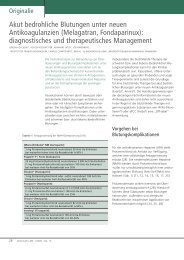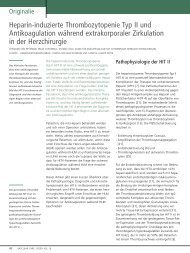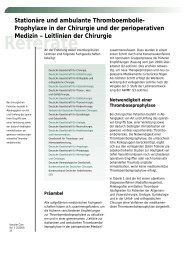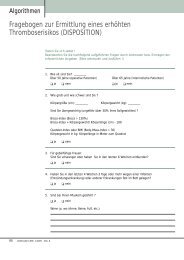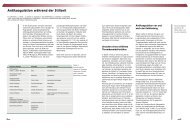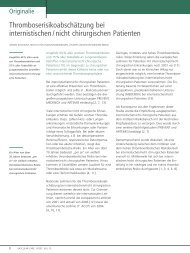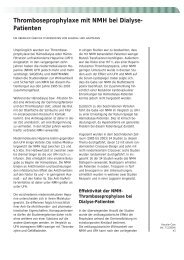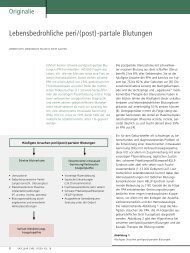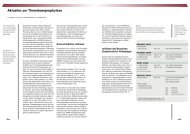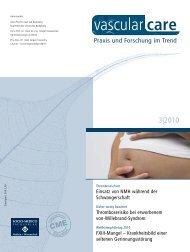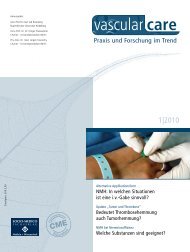HIT Typ II in der operativen Medizin ... - Vascularcare.de
HIT Typ II in der operativen Medizin ... - Vascularcare.de
HIT Typ II in der operativen Medizin ... - Vascularcare.de
- Keine Tags gefunden...
Sie wollen auch ein ePaper? Erhöhen Sie die Reichweite Ihrer Titel.
YUMPU macht aus Druck-PDFs automatisch weboptimierte ePaper, die Google liebt.
[74] Kodityal S, Manhas AH, Ud<strong>de</strong>n M, Rice L: Danaparoid for hepar<strong>in</strong><strong>in</strong>ducedthrombocytopenia: an analysis of treatment failures. Eur JHaematol 71 (2003) 109–13[75] Koster A, Hansen R, Kuppe H, Hetzer R, Crystal GJ, Mertzlufft F:Recom-b<strong>in</strong>ant hirud<strong>in</strong> as an alternative for anticoagulation dur<strong>in</strong>gcardiopulmonary bypass <strong>in</strong> patients with hepar<strong>in</strong>-<strong>in</strong>ducedthrombocytopenia type <strong>II</strong>: a 1-year experience <strong>in</strong> 57 patients.J Cardiothorac Vasc Anesth 14 (2000) 243–48[76] Koster A, Sanger S, Hansen R, Sodian R, Mertzlufft F, Harke C,Kuppe H, Hetzer R, Loebe M: Prevalence and persistence ofhepar<strong>in</strong>/platelet factor 4 antibodies <strong>in</strong> patients with hepar<strong>in</strong>coated and noncoated ventricular assist <strong>de</strong>vices. ASAIO J 46(2000) 319–22[77] Koster A, Spiess B, Chew DP, Krabatsch T, Tambeur L, DeAnda A,Hetzer R, Kuppe H, Smedira NG, L<strong>in</strong>coff AM: Effectiveness ofbivalirud<strong>in</strong> as a replacement for hepar<strong>in</strong> dur<strong>in</strong>g cardiopulmonarybypass <strong>in</strong> patients un<strong><strong>de</strong>r</strong>go<strong>in</strong>g coronary artery bypass graft<strong>in</strong>g.Am J Cardiol 93 (2004) 356-9[78] Kozek-Langenecker SA, Spiss CK, Gamsjager T, Domenig C,Zimpfer M: Anticoagulation with prostagland<strong>in</strong>s and unfractionatedhepar<strong>in</strong> dur<strong>in</strong>g cont<strong>in</strong>uous venovenous haemofiltration: a randomizedcontrolled trial. Wien Kl<strong>in</strong> Wschr 114 (2002) 96–101[79] Kozek-Langenecker SA, Spiss CK, Michalek-Sauberer A, FelfernigM, Zimpfer M: Effect of prostacycl<strong>in</strong> on platelets, polymorphonuclearcells, and heterotypic cell aggregation dur<strong>in</strong>g hemofiltration.Crit Care Med 31 (2003) 864–68[80] Kramer L, Bauer E, Joukhadar C, Strobl W, Gendo A, Madl C,Gangl A: Citrate pharmacok<strong>in</strong>etics and metabolism <strong>in</strong> cirrhoticand noncirrhotic critically ill patients. Crit Care Med 31 (2003)2450–55[81] Lagrange F, Brun JL, Vergnes MC, Paolucci F, Nadal T, Leng JJ,Saux MC, Bannwarth B: Fondapar<strong>in</strong>ux sodium does not cross theplacental barrier: study us<strong>in</strong>g the <strong>in</strong>-vitro human dually perfusedcotyledon mo<strong>de</strong>l. Cl<strong>in</strong> Pharmacok<strong>in</strong>et 41 Suppl 2 (2002) 47–49[82] Langenecker SA, Felfernig M, Werba A, Mueller CM, Chiari A,Zimpfer M: Anticoagulation with prostacycl<strong>in</strong> and hepar<strong>in</strong> dur<strong>in</strong>gcont<strong>in</strong>uous venovenous hemofiltration. Crit Care Med 22 (1994)1774–81[83] Langenecker SA, Felfernig M, Werba A, Mueller CM, Chiari A,Zimpfer M: Anticoagulation with prostacycl<strong>in</strong> and hepar<strong>in</strong>dur<strong>in</strong>g cont<strong>in</strong>uous venovenous hemofiltration. Crit Care Med 22(1994) 1774–81[84] Lebrazi J, Elalamy I, Samama MM: In vitro effect of melagatranand lepirud<strong>in</strong> on clot-bound thromb<strong>in</strong>. Thromb Res 110 (2003)249–52[85] Lefevre G, Duval M, Gauron S, Brookman LJ, Rolan PE, Morris TM,Pira<strong>in</strong>o AJ, Morgan JM, Palmisano M, Close P: Effect of renalimpairment on the pharmacok<strong>in</strong>etics and pharmacodynamics of<strong>de</strong>sirud<strong>in</strong>. Cl<strong>in</strong> Pharmacol Ther 62 (1997) 50–59[86] Lewis BE, Wallis DE, Leya F, Hurst<strong>in</strong>g MJ, Kelton JG, Argatroban-915 Investigators: Argatroban anticoagulation <strong>in</strong> patients withhepar<strong>in</strong>-<strong>in</strong>duced thrombocytopenia. Arch Intern Med 163 (2003)1849–56[87] L<strong>in</strong>coff AM, Bittl JA, Kleiman NS, Sarembock IJ, Jackman JD,Mehta S, Tannenbaum MA, Nie<strong><strong>de</strong>r</strong>man AL, Bach<strong>in</strong>sky WB, Tift-Mann J 3rd, Parker HG, Kereiakes DJ, Harr<strong>in</strong>gton RA, Feit F,Maierson ES, Chew DP, Topol EJ; REPLACE-1 Investigators.Comparison of bivalirud<strong>in</strong> versus hepar<strong>in</strong> dur<strong>in</strong>g percutaneouscoronary <strong>in</strong>tervention (the Randomized Evaluation of PCI L<strong>in</strong>k<strong>in</strong>gAngiomax to Reduced Cl<strong>in</strong>ical Events [REPLACE]-1 trial).Am J Cardiol 93 (2004) 1092-6[88] L<strong>in</strong>dhoff-Last E, Bauersachs R: Hepar<strong>in</strong>-<strong>in</strong>duced thrombocytopenia-alternativeanticoagulation <strong>in</strong> pregnancy and lactation. Sem<strong>in</strong>Thromb Hemost 28 (2002) 439–46[89] L<strong>in</strong>dhoff-Last E, Eichler P, Ste<strong>in</strong> M, Plagemann J, Gerdsen F,Wagner R, Ehrly AM, Bauersachs R: A prospective study on the<strong>in</strong>ci<strong>de</strong>nce and cl<strong>in</strong>ical relevance of hepar<strong>in</strong>-<strong>in</strong>duced antibodies <strong>in</strong>patients after vascular surgery. Thromb Res 15, 97 (2000) 387–93[90] Lisman T, Bijsterveld NR, A<strong>de</strong>lmeijer J, Meijers JC, Levi M,Nieuwenhuis HK, <strong>de</strong> Groot PG: Recomb<strong>in</strong>ant factor V<strong>II</strong>a reversesthe <strong>in</strong> vitro and ex vivo anticoagulant and profibr<strong>in</strong>olytic effectsof fondapar<strong>in</strong>ux. J Thromb Haemost 1 (2003) 2368–73[91] Lucas FV, Skr<strong>in</strong>ska VA, Chisolm GM, Hesse BL: Stability of prostacycl<strong>in</strong><strong>in</strong> human and rabbit whole blood and plasma. Thromb Res43 (1986) 379–87[92] Macchi L, Sarfati R, Guicheteau M: Thromboembolic prophylaxiswith danaparoid (Orgaran) <strong>in</strong> a high-thrombosis-risk pregnantwoman with a history of hepar<strong>in</strong>-<strong>in</strong>duced thrombocytopenia (<strong>HIT</strong>)and Widal's disease. Cl<strong>in</strong> Appl Thromb Hemost 6 (2000) 187–89[93] Maetzke J, H<strong>in</strong>richs R, Staib G, Scharffetter-Kochanek K:Fondapar<strong>in</strong>ux as a novel therapeutic alternative <strong>in</strong> a patient withhepar<strong>in</strong> allergy. Allergy 59 (2004) 237–38[94] Magnani HN: Hepar<strong>in</strong>-<strong>in</strong>duced thrombocytopenia (<strong>HIT</strong>): an overviewof 230 patients treated with orgaran (Org 10172). ThrombHaemost 70 (1993) 554–61[95] Markwardt F, F<strong>in</strong>k G, Kaiser B: Pharmacological survey of recomb<strong>in</strong>anthirud<strong>in</strong>. Pharmazie 43 (1988) 202–7[96] Markwardt F: Untersuchungen über <strong>de</strong>n Mechanismus <strong><strong>de</strong>r</strong> blutger<strong>in</strong>nungshemmen<strong>de</strong>nWirkung <strong>de</strong>s Hirud<strong>in</strong>s. N.-S. Arch Pharmacol229 (1956) 389–99VASCULAR CARE 1/2005 VOL. 8 51



